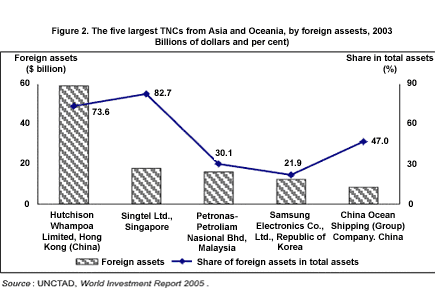|
Foreign direct investment (FDI) in the region of Asia and Oceania broke records in 2004, according to UNCTAD´s World Investment Report 2005: Transnational Corporations and the Internationalization of R&D. The report, released yesterday, says the region received $148 billion in FDI - $46 billion more than in 2003 - making it the top recipient among developing regions. Rapid economic growth, an improved policy environment, and increasing strategic commitments to Asian markets by transnational corporations (TNCs) contributed to the surge.
China again emerged the largest recipient of FDI inflows, not only among all countries in the region but among developing countries worldwide. FDI in China attained another record of $60.6 billion. Flows to Hong Kong, China, amounted to $34 billion, a 150 per cent increase and the highest investment growth rate among the region's economies. Together, China and Hong Kong accounted for two thirds of all FDI in this part of the world. 
Among the various sub-regions of Asia, East Asia remained the preferred target last year, with a 46 per cent gain; in terms of FDI growth, West Asia performed the best; its foreign investments were up by 51 per cent, to $9.8 billion. This was due to high oil prices, efforts to diversify, and a series of liberalisation measures aimed at improving the investment climate, the UNCTAD report states.
South-east Asia (comprising the 10 member states of the ASEAN and Timor-Leste) saw a further rise in inflows - from $17 billion in 2003 to $26 billion in 2004 - the steepest increase since the 1997-1998 financial crisis. In fact, the climb in investment there shows that the impact of the crisis on FDI inflows is now a thing of the past, the report suggests.
FDI in South Asia increased by 31 per cent to $7 billion because of higher flows to India, Pakistan and Bangladesh. By contrast, Oceania (the Pacific island economies) suffered a 54 per cent decline in FDI last year, to $ 67 million.
While greenfield investment remained the most important mode of FDI in the region, cross-border mergers and acquisitions (M&As) continued to increase, particularly in the services sector. This was due largely to a rise in M&A transactions in East Asia, UNCTAD says. FDI in research and development (R&D), a relatively new area of growth for transnational corporations (TNCs) in developing countries, has expanded rapidly in developing Asia in recent years.
Some countries have become important destinations for FDI in R&D, especially China and India, both of which have large pools of technically well-qualified workers. In China, the number of foreign affiliate R&D centres climbed to 700 in 2004; in India, more than 100 TNCs have established R&D facilities. In addition, some relatively small-sized economies have attracted R&D by TNCs. Thailand, for example, was recently selected as the site of Toyota´s fourth overseas R&D centre. Outward FDI
Outward FDI from Asia and Oceania quadrupled to $69 billion last year, driven particularly by flows of $40 billion from Hong Kong, China, the report notes. Outflows from the Republic of Korea and Singapore also rose sharply, as did those from China and India.
Intra-regional FDI has expanded considerably in recent years, encouraged by regional integration efforts, the expansion of production networks and the relocation of production to lower-cost areas. Of UNCTAD´s list of top 50 developing-country TNCs, 39 are based in Asia, and four of those 39 rank among the 100 largest TNCs. 
Ranked 16th globally in terms of foreign assets, Hutchison Whampoa (Hong Kong, China) is the region´s leading TNC. Some Chinese, Indian and Korean firms in the information and communications technology field have been actively expanding their R&D activities abroad.
Flows to South-East Asia, led by India, are set to surge, for the third consecutive year, as the policy environment for FDI continues to improve within the region. Prospects for both inward and outward FDI remain promising, the report says. FDI to China is expected to rise yet again this year, led by flows to the services sector.
In West Asia, the upward trend in FDI inflows should persist through 2005, notably in oil- and gas-related industries in response to increasing world demand. The report predicts a recovery by the Oceania sub-region in FDI flows this year. And as TNCs constantly seek to improve their competitiveness by reducing costs in highly knowledge-intensive activities, the rapid expansion of R&D by TNCs in developing Asia will most probably continue as well, the report posits.
Chinese, Indian and Korean firms will account for an increasing proportion of an expected continued growth in FDI outflows from the region during 2005, including through large-scale overseas mergers and acquisitions, UNCTAD foresees. China is set to become a major foreign investor in Latin America, driven by its growing demand for natural resources and commodities with which to fuel its rapid economic growth. Chinese investments in developed countries will also mount, as exemplified by Lenovo´s takeover of IBM´s PC business.
Because of the huge amount of "Chinese dollars" still rapidly accumulating, as well as other developments, China is seeking to acquire corporate equities in the United States rather than continuing to serve merely as a large holder of US Treasury bonds. This trend has been illustrated by recent Chinese corporate bids for companies in the United States.
also see : Click
Here to view full report
|